Intel Core i7-10700 vs Core i7-10700K Review: Is 65W Comet Lake an Option?
by Dr. Ian Cutress on January 21, 2021 10:30 AM EST- Posted in
- CPUs
- Intel
- Core i7
- Z490
- 10th Gen Core
- Comet Lake
- i7-10700K
- i7-10700
CPU Tests: Office and Science
Our previous set of ‘office’ benchmarks have often been a mix of science and synthetics, so this time we wanted to keep our office section purely on real world performance.
Agisoft Photoscan 1.3.3: link
The concept of Photoscan is about translating many 2D images into a 3D model - so the more detailed the images, and the more you have, the better the final 3D model in both spatial accuracy and texturing accuracy. The algorithm has four stages, with some parts of the stages being single-threaded and others multi-threaded, along with some cache/memory dependency in there as well. For some of the more variable threaded workload, features such as Speed Shift and XFR will be able to take advantage of CPU stalls or downtime, giving sizeable speedups on newer microarchitectures.
For the update to version 1.3.3, the Agisoft software now supports command line operation. Agisoft provided us with a set of new images for this version of the test, and a python script to run it. We’ve modified the script slightly by changing some quality settings for the sake of the benchmark suite length, as well as adjusting how the final timing data is recorded. The python script dumps the results file in the format of our choosing. For our test we obtain the time for each stage of the benchmark, as well as the overall time.
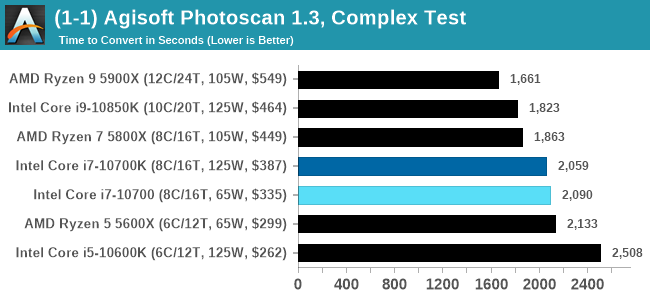
The 10700K takes a small lead.
Application Opening: GIMP 2.10.18
First up is a test using a monstrous multi-layered xcf file to load GIMP. While the file is only a single ‘image’, it has so many high-quality layers embedded it was taking north of 15 seconds to open and to gain control on the mid-range notebook I was using at the time.
What we test here is the first run - normally on the first time a user loads the GIMP package from a fresh install, the system has to configure a few dozen files that remain optimized on subsequent opening. For our test we delete those configured optimized files in order to force a ‘fresh load’ each time the software in run. As it turns out, GIMP does optimizations for every CPU thread in the system, which requires that higher thread-count processors take a lot longer to run.
We measure the time taken from calling the software to be opened, and until the software hands itself back over to the OS for user control. The test is repeated for a minimum of ten minutes or at least 15 loops, whichever comes first, with the first three results discarded.
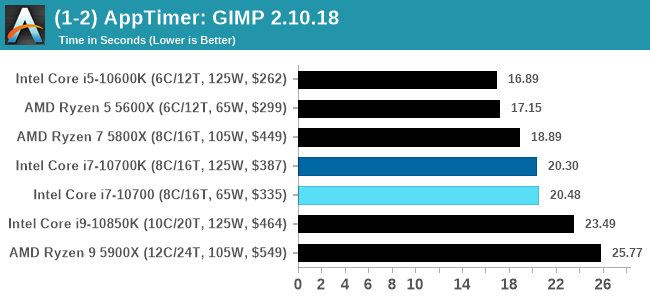
The 10700K takes a small lead.
Science
In this version of our test suite, all the science focused tests that aren’t ‘simulation’ work are now in our science section. This includes Brownian Motion, calculating digits of Pi, molecular dynamics, and for the first time, we’re trialing an artificial intelligence benchmark, both inference and training, that works under Windows using python and TensorFlow. Where possible these benchmarks have been optimized with the latest in vector instructions, except for the AI test – we were told that while it uses Intel’s Math Kernel Libraries, they’re optimized more for Linux than for Windows, and so it gives an interesting result when unoptimized software is used.
3D Particle Movement v2.1: Non-AVX and AVX2/AVX512
This is the latest version of this benchmark designed to simulate semi-optimized scientific algorithms taken directly from my doctorate thesis. This involves randomly moving particles in a 3D space using a set of algorithms that define random movement. Version 2.1 improves over 2.0 by passing the main particle structs by reference rather than by value, and decreasing the amount of double->float->double recasts the compiler was adding in.
The initial version of v2.1 is a custom C++ binary of my own code, and flags are in place to allow for multiple loops of the code with a custom benchmark length. By default this version runs six times and outputs the average score to the console, which we capture with a redirection operator that writes to file.
For v2.1, we also have a fully optimized AVX2/AVX512 version, which uses intrinsics to get the best performance out of the software. This was done by a former Intel AVX-512 engineer who now works elsewhere. According to Jim Keller, there are only a couple dozen or so people who understand how to extract the best performance out of a CPU, and this guy is one of them. To keep things honest, AMD also has a copy of the code, but has not proposed any changes.
The 3DPM test is set to output millions of movements per second, rather than time to complete a fixed number of movements.
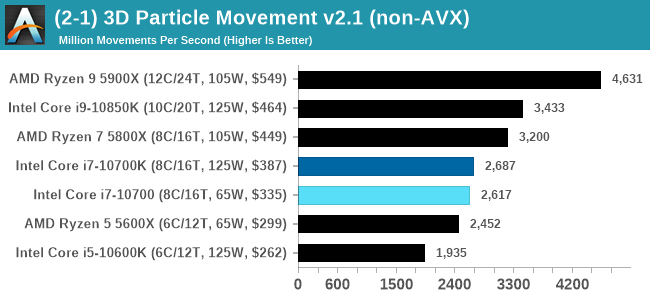
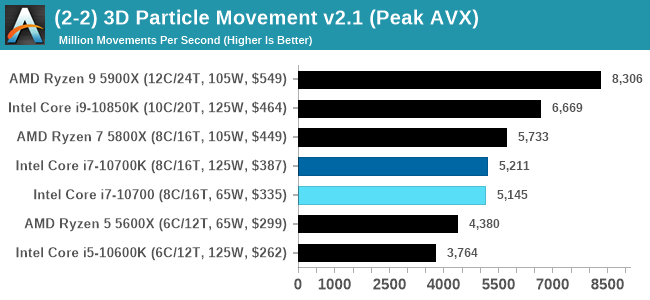
The 10700K takes a small lead (this is going to be a recurring theme).
y-Cruncher 0.78.9506: www.numberworld.org/y-cruncher
If you ask anyone what sort of computer holds the world record for calculating the most digits of pi, I can guarantee that a good portion of those answers might point to some colossus super computer built into a mountain by a super-villain. Fortunately nothing could be further from the truth – the computer with the record is a quad socket Ivy Bridge server with 300 TB of storage. The software that was run to get that was y-cruncher.
Built by Alex Yee over the last part of a decade and some more, y-Cruncher is the software of choice for calculating billions and trillions of digits of the most popular mathematical constants. The software has held the world record for Pi since August 2010, and has broken the record a total of 7 times since. It also holds records for e, the Golden Ratio, and others. According to Alex, the program runs around 500,000 lines of code, and he has multiple binaries each optimized for different families of processors, such as Zen, Ice Lake, Sky Lake, all the way back to Nehalem, using the latest SSE/AVX2/AVX512 instructions where they fit in, and then further optimized for how each core is built.
For our purposes, we’re calculating Pi, as it is more compute bound than memory bound. In single thread mode we calculate 250 million digits, while in multithreaded mode we go for 2.5 billion digits. That 2.5 billion digit value requires ~12 GB of DRAM, and so is limited to systems with at least 16 GB.
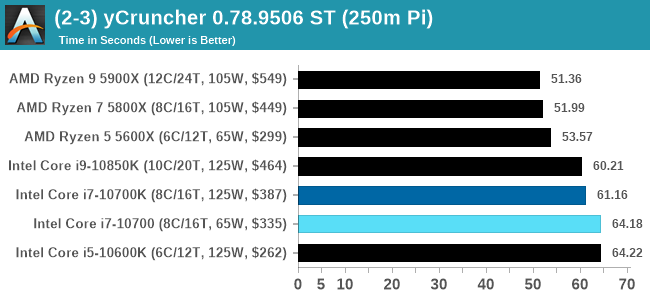
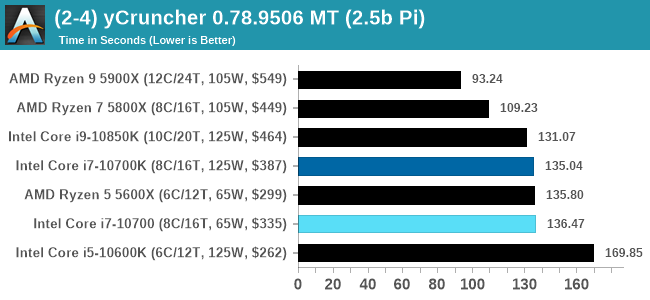
NAMD 2.13 (ApoA1): Molecular Dynamics
One of the popular science fields is modeling the dynamics of proteins. By looking at how the energy of active sites within a large protein structure over time, scientists behind the research can calculate required activation energies for potential interactions. This becomes very important in drug discovery. Molecular dynamics also plays a large role in protein folding, and in understanding what happens when proteins misfold, and what can be done to prevent it. Two of the most popular molecular dynamics packages in use today are NAMD and GROMACS.
NAMD, or Nanoscale Molecular Dynamics, has already been used in extensive Coronavirus research on the Frontier supercomputer. Typical simulations using the package are measured in how many nanoseconds per day can be calculated with the given hardware, and the ApoA1 protein (92,224 atoms) has been the standard model for molecular dynamics simulation.
Luckily the compute can home in on a typical ‘nanoseconds-per-day’ rate after only 60 seconds of simulation, however we stretch that out to 10 minutes to take a more sustained value, as by that time most turbo limits should be surpassed. The simulation itself works with 2 femtosecond timesteps. We use version 2.13 as this was the recommended version at the time of integrating this benchmark into our suite. The latest nightly builds we’re aware have started to enable support for AVX-512, however due to consistency in our benchmark suite, we are retaining with 2.13. Other software that we test with has AVX-512 acceleration.
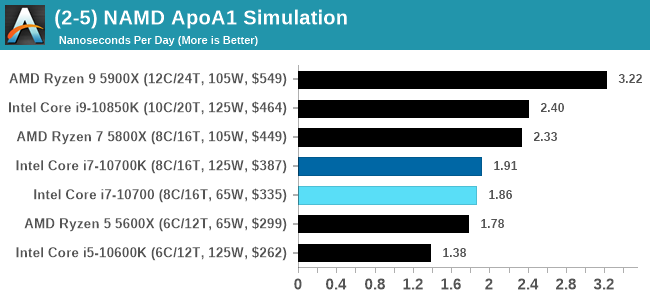
AI Benchmark 0.1.2 using TensorFlow: Link
Finding an appropriate artificial intelligence benchmark for Windows has been a holy grail of mine for quite a while. The problem is that AI is such a fast moving, fast paced word that whatever I compute this quarter will no longer be relevant in the next, and one of the key metrics in this benchmarking suite is being able to keep data over a long period of time. We’ve had AI benchmarks on smartphones for a while, given that smartphones are a better target for AI workloads, but it also makes some sense that everything on PC is geared towards Linux as well.
Thankfully however, the good folks over at ETH Zurich in Switzerland have converted their smartphone AI benchmark into something that’s useable in Windows. It uses TensorFlow, and for our benchmark purposes we’ve locked our testing down to TensorFlow 2.10, AI Benchmark 0.1.2, while using Python 3.7.6.
The benchmark runs through 19 different networks including MobileNet-V2, ResNet-V2, VGG-19 Super-Res, NVIDIA-SPADE, PSPNet, DeepLab, Pixel-RNN, and GNMT-Translation. All the tests probe both the inference and the training at various input sizes and batch sizes, except the translation that only does inference. It measures the time taken to do a given amount of work, and spits out a value at the end.
There is one big caveat for all of this, however. Speaking with the folks over at ETH, they use Intel’s Math Kernel Libraries (MKL) for Windows, and they’re seeing some incredible drawbacks. I was told that MKL for Windows doesn’t play well with multiple threads, and as a result any Windows results are going to perform a lot worse than Linux results. On top of that, after a given number of threads (~16), MKL kind of gives up and performance drops of quite substantially.
So why test it at all? Firstly, because we need an AI benchmark, and a bad one is still better than not having one at all. Secondly, if MKL on Windows is the problem, then by publicizing the test, it might just put a boot somewhere for MKL to get fixed. To that end, we’ll stay with the benchmark as long as it remains feasible.
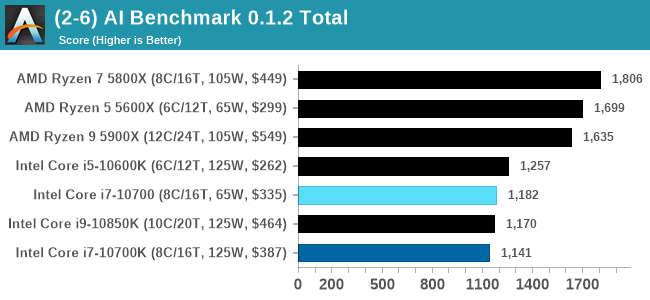




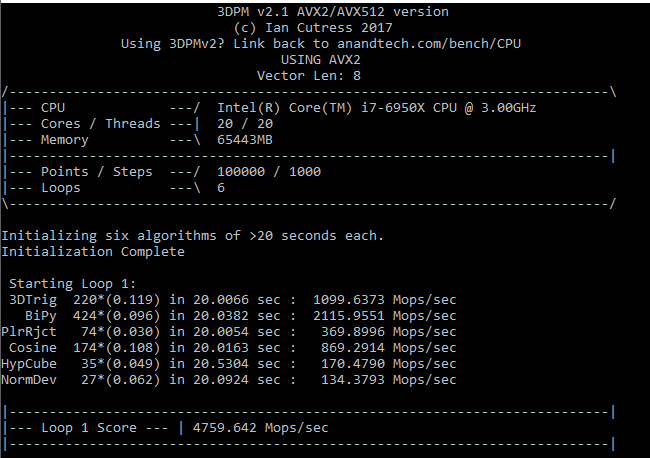
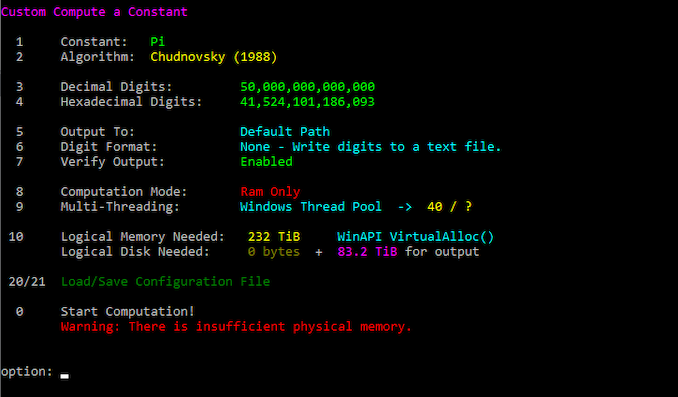
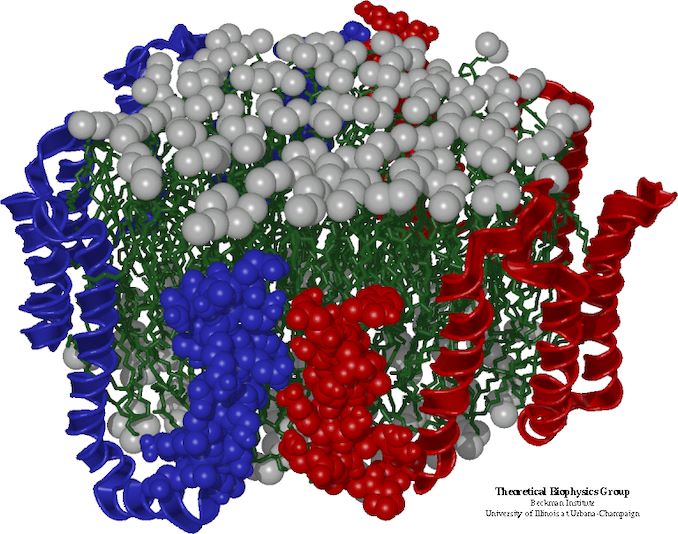









210 Comments
View All Comments
blckgrffn - Thursday, January 21, 2021 - link
Thanks for the review, as it basically shows what other reviews already show, namely if you set aggressive PL1 and PL2 values across K & non K SKUs then you'll get similar performance.I am curious why you said the performance is much lower with a 65W power limit and then didn't include those results.
I feel like it is common knowledge, especially with 10th Gen Intel CPUs that you need to manually configure PL1 and PL2 in keeping with your cooling solution, but perhaps not.
blckgrffn - Thursday, January 21, 2021 - link
I mean, published PL1 for this CPU is 10700 is 65, PL2 is 224 for 28 seconds.Running outside of those value is essentially turbo overclocking (yeah, I know Intel has also redefined that term).
If your motherboard auto overclocks the CPU via a ridiculous PL1 value then ¯\_(ツ)_/¯
Tunnah - Thursday, January 21, 2021 - link
Intel has no incentive to change their policy and label their products with the actual power draw they'll be using because they'll show how much more they suck up compared to AMD. People are constantly looking for metrics to compare the 2 "teams", and Intel getting to keep the labels of 65w and 125w lets the fans say "see it has the same power usage as AMD!"yeeeeman - Thursday, January 21, 2021 - link
this looks just fine to me as long as it is clear for the user.magreen - Friday, January 22, 2021 - link
But it is not.porina - Thursday, January 21, 2021 - link
From my observations of Zen 2 at stock operation, 65W TDP models tended to sit continuously at the 88W PPT limit under most all-core load conditions. Has this changed with Zen 3? Do they not hit 88W so easily, or is another (current) limiter taking over? Or is the limit a different value now?Smell This - Friday, January 22, 2021 - link
Presumably, the Zen3 would operate under the same 'constraints' ----- The constraints are as follows:
♦ Package Power Tracking (PPT): The power threshold that is allowed to be delivered to the socket. This is 88W for 65W TDP processors, and 142W for 105W TDP processors.
♦ Thermal Design Current (TDC): The maximum amount of current delivered by the motherboard’s voltage regulators when under thermally constrained scenarios (high temperatures). This is 60A for 65W TDP processors, and 95A for 105W TDP processors.
♦ Electrical Design Current (EDC): This is the maximum amount of current at any instantaneous short period of time that can be delivered by the motherboard’s voltage regulators. This is 90A for 65W TDP processors, and 140A for 105W TDP processors.
"Looking at the total power consumption of the new 3700X, the chip is very much seemingly hitting and maintaining the 88W PPT limitations of the default settings, and we’re measuring 90W peak consumption across the package."
Olaf van der Spek - Thursday, January 21, 2021 - link
Why would one want to limit turbo budgets? Thermals? If there's no thermal headroom the CPU won't turbo (as far).Efficiency?
Calin - Friday, January 22, 2021 - link
The motherboard has power limits - both in instant maximum current from the voltage regulation phase (remember, the mainboard receives 3.3 Volts, 5V, 12V and maybe -5V and -12V from the PSU and has to convert that to processor voltage), and in cooling capacity for the VRM (Voltage Regulation Module).Regardless of the power limits, the processor will slow down if its internal temperature is too great.
So yes, the "my mainboard's power delivery module cannot deliver more than 80 amps" is a possible reason. Another would be "My case has bad cooling and I want to keep the processor colder". Another would be "As soon as the sustained power goes over 140 watts, the fans in the case start whirring and I hate the sound".
DominionSeraph - Thursday, January 21, 2021 - link
>This does come with a reasonably good default cooler.No. Just no. The Ryzen coolers are utter trash and you're doing a disservice to your readers who may not have ever had a quiet cooler to say otherwise. I build PCs and I've had several Ryzens go through and I have never seen one where I would call the acoustics livable. My first sale was a 1700 with the stock cooler since I didn't have any other AM4 compatible ones at the time and I still feel bad about selling it that way. It was just terrible. The 212 EVO seems to be within its thermal envelope for quiet cooling up to a stock 3700X, so I'd highly recommend one of those over the stock cooler. Going above the ~85W of a 3700X you should spring for a Fuma 2.